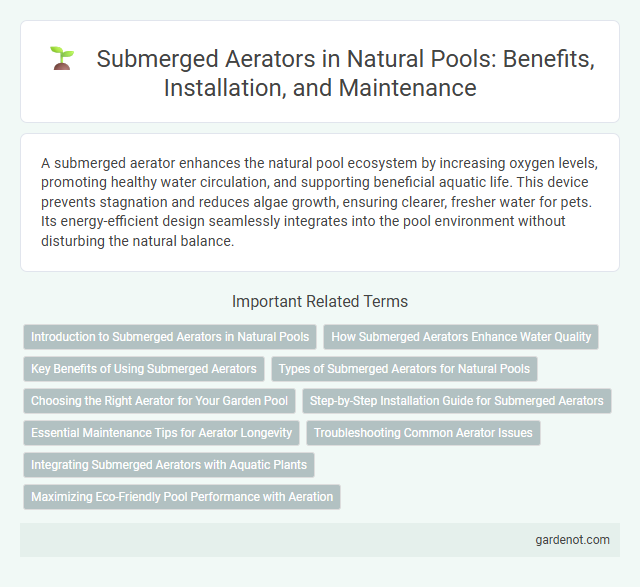A submerged aerator enhances the natural pool ecosystem by increasing oxygen levels, promoting healthy water circulation, and supporting beneficial aquatic life. This device prevents stagnation and reduces algae growth, ensuring clearer, fresher water for pets. Its energy-efficient design seamlessly integrates into the pool environment without disturbing the natural balance.
Introduction to Submerged Aerators in Natural Pools
Submerged aerators are essential components in natural pools, enhancing water quality by increasing oxygen levels beneath the surface. These devices stimulate beneficial microbial activity that breaks down organic matter, helping maintain clear, balanced ecosystems without chemical additives. Efficient oxygenation through submerged aerators supports healthy aquatic flora and fauna, ensuring a sustainable and natural swimming environment.
How Submerged Aerators Enhance Water Quality
Submerged aerators significantly improve water quality in natural pools by increasing dissolved oxygen levels, which supports beneficial aerobic bacteria that break down organic matter and reduce harmful algae growth. These aerators facilitate continuous water circulation, preventing stagnation and promoting the natural filtration process by distributing oxygen evenly throughout the pool. Enhanced oxygenation also helps maintain clear, healthy water, creating an optimal environment for aquatic plants and microorganisms essential to the ecosystem.
Key Benefits of Using Submerged Aerators
Submerged aerators significantly enhance water quality in natural pools by increasing oxygen levels and promoting beneficial microbial activity, which accelerates organic matter breakdown. These devices reduce algae growth and prevent stagnation, resulting in clearer, healthier water with minimal chemical usage. Improved circulation from submerged aerators also supports aquatic ecosystems, sustaining biodiversity and ensuring balanced natural pool maintenance.
Types of Submerged Aerators for Natural Pools
Submerged aerators for natural pools include diffuser aerators, which release fine bubbles to oxygenate water evenly, and venturi aerators, which mix air with water using pressure differences to enhance circulation. Rotor aerators use rotating blades beneath the surface to increase water movement and oxygen transfer efficiently. Choice of aerator depends on pool size, desired oxygen levels, and ecological balance requirements.
Choosing the Right Aerator for Your Garden Pool
Selecting the right submerged aerator for your natural garden pool enhances water circulation and oxygenation, critical for maintaining aquatic plant health and preventing stagnation. Factors such as pool size, depth, and desired flow rate determine the optimal aerator capacity and power, ensuring efficient performance without disturbing the ecosystem balance. Energy-efficient models with adjustable flow settings provide tailored aeration, promoting a thriving natural pool environment year-round.
Step-by-Step Installation Guide for Submerged Aerators
Place the submerged aerator at the deepest section of the natural pool to maximize oxygen distribution and promote water circulation. Connect the aerator to the power source and ensure all wiring is waterproof and secured to prevent electrical hazards. Test the system by turning it on and monitor air bubbles rising, adjusting placement or air flow as needed for optimal aeration performance.
Essential Maintenance Tips for Aerator Longevity
Regularly inspect the submerged aerator for debris buildup and clean the diffuser plates to ensure optimal oxygen transfer efficiency. Maintain proper water chemistry by monitoring pH and alkalinity levels to prevent corrosion and biological clogging. Schedule seasonal checks to lubricate moving parts and verify electrical connections for uninterrupted aerator performance in natural pools.
Troubleshooting Common Aerator Issues
Submerged aerators in natural pools often face clogging caused by debris or algae buildup, reducing oxygen circulation and water clarity. Regular inspection and cleaning of diffuser plates and air intake lines can restore optimal aeration performance and prevent mechanical damage. Monitoring the compressor and replacing worn seals ensures consistent air pressure and prevents system failure.
Integrating Submerged Aerators with Aquatic Plants
Integrating submerged aerators with aquatic plants enhances oxygen distribution directly at the root zones, promoting healthier plant growth and improving water quality. This synergy increases the efficiency of nutrient cycling and reduces algae proliferation by maintaining balanced oxygen levels throughout the natural pool. Proper placement of submerged aerators ensures that aquatic plants receive continuous aeration without disrupting their natural habitat.
Maximizing Eco-Friendly Pool Performance with Aeration
Submerged aerators enhance natural pools by increasing oxygen levels and promoting beneficial microbial activity, which improves water clarity and supports aquatic life. By reducing harmful algae growth and balancing ecosystem nutrients, these devices maintain a healthy, chemical-free environment. Optimizing aeration ensures sustainable, eco-friendly performance while preserving the pool's natural habitat.
Submerged aerator Infographic

 gardenot.com
gardenot.com